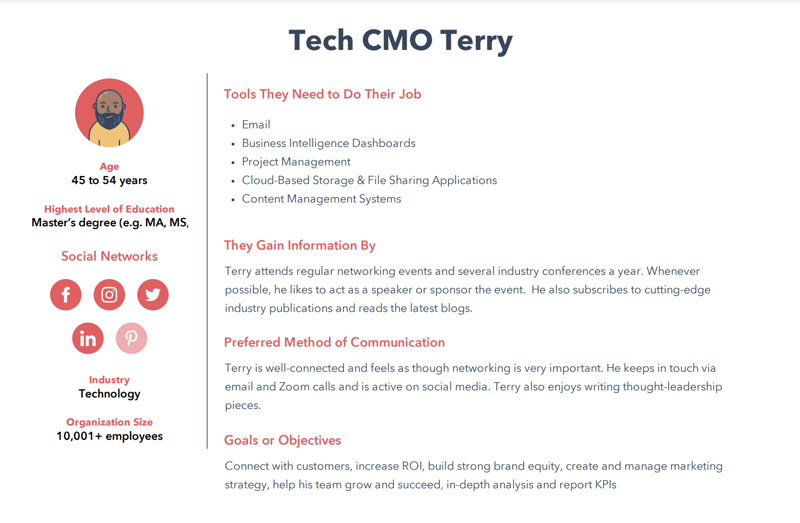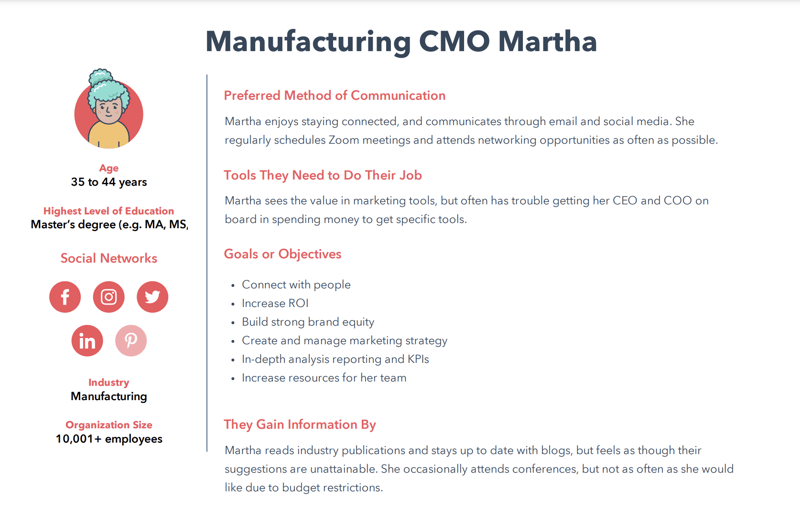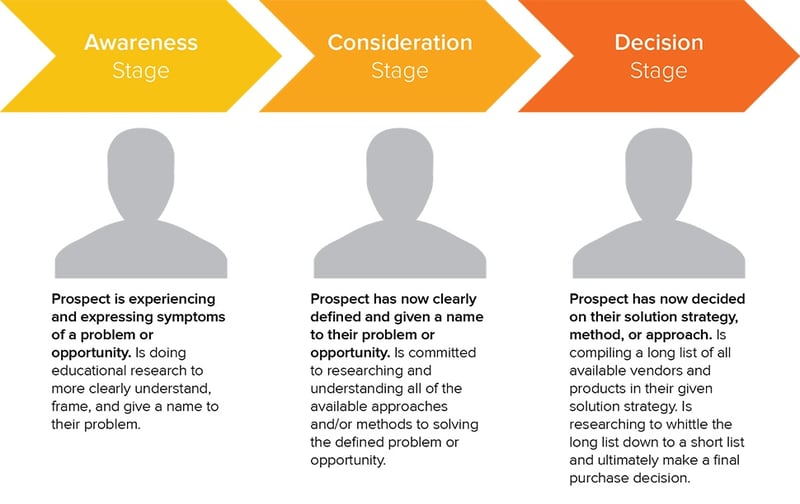How to Use Buyer Personas for Your Target Industries

For a marketing and/or sales-driven organization, having a well-developed sense of your buyer personas is essential. Personas reinforce and solidify your segmentation strategy and empower you to craft relevant customer experiences for prospects who mean the most to your business.
If your buyer personas are tailored to fit your audiences, your marketing strategy will be that much more effective.
That explains why it’s beneficial to your business, but why is segmentation so vital when it comes to the customer experience?
The differences separating your target audience are far more unique than just industry experiences, job titles, and educational backgrounds. Other differentiating factors include:
- Concerns and pain points
- Business goals
- Busy times
- Motives
- Needs
- Industry-related events
- Jargon, acronyms, etc.
- Buyer’s journeys
- Sources of news and information
- Expectations for vendor relationships
With so many differences, it’s hard to imagine why you would address two completely distinct segments in the same way!
To demonstrate this point, we used HubSpot’s Make My Persona tool to create buyer personas in two different industries: Tech CMO Terry and Manufacturing CMO Martha.
This tool not only encourages a discussion around the particular demographic and behavioral characteristics of a persona, but it allows you to understand why those differences matter in a business context.
Related reading: 5 Questions to Ask When Building a Sub-Brand Strategy
For instance, it’s one thing to identify a difference in age, title, or education, but it’s more actionable to define how those differences impact different buyers’ communication preferences and purchase journeys.
Take a look at Tech CMO Terry and Manufacturing CMO Martha to see how we used key differences in their industries to help define their behaviors and concerns:


It’s clear Tech Terry and Manufacturing Martha have a lot in common—but they also have some pretty major differences.
Tech Terry’s main priorities are distinguishing his brand from the competition, controlling his brand’s large online presence, and personalizing his marketing outreach.
Manufacturing Martha’s concerns, however, are with building a brand presence, capturing the attention of potential hires, and proving her marketing efforts are worthwhile.
By considering the factors above, we are able to identify Tech Terry’s and Manufacturing Martha’s vastly different pain points, processes, and budgets. From there, we can use these details to communicate with our audiences in a meaningful way.
So now that you have identified industry-specific buyer personas, what do you do with them?
Create an action plan with your new buyer personas
To be successful, your buyer personas need to be a part of everything your company does. According to Marketing Insider Group, companies that exceed lead and revenue goals are four times as likely to use buyer personas.
So, how do you incorporate them into every customer touchpoint? Now that you’re armed with newly minted buyer personas, here’s how to implement them:
1. Generate focused content
Write to your buyer personas, instead of about them.
Imagine you are writing directly to Tech Terry or Manufacturing Martha. What style of writing do they respond to? Tech Terry might enjoy a relaxed, friendly tone, while Manufacturing Martha would rather you respect her time and get straight to the facts.
Once you’ve got the tone down, consider how they make their decisions and what problems they may be facing.
Map out your content ideas based on your persona’s decision-making processes. If your persona has a slow decision-making process with several barriers, like Manufacturing Martha, you may need to generate more content for each of the three stages of the buyer’s journey.
Tech Terry, who has a larger budget and well-established CEO buy-in may be able to make decisions on his own, and therefore more willing to try something groundbreaking.
Manufacturing Martha, on the other hand, may not have the budget nor full decision-making power. She may have to include more people in her decisions and may choose tried-and-true methods over the latest technology.
For Tech Terry, you may want to write an article titled ‘X Ways to Market Your New Tech’. A piece about ‘How to Get Budget Buy-In From Your CEO’ may resonate more with Manufacturing Martha.
Make sure you are speaking their language, using acronyms and jargon only when appropriate.
Whether it’s an email, a tweet, a video, your website content, or anything else, write with your personas in mind.
Related reading: Why Your Website Project Needs A Content Strategy
2. Distribute content on their preferred channels
Manufacturing Martha, who is trying to market her company to potential employees, may spend a lot of time on LinkedIn checking out what other companies are doing—and almost no time on other social media channels.
Tech Terry, who considers himself to be a thought leader, may spend more time on Twitter exploring the latest trends. If you want your content to be consumed by your target audience, promote your content on the channel they’re using the most.
This means you may need to reallocate some of your ad spending. If Manufacturing Martha and Tech Terry aren’t spending much time on Facebook, you shouldn’t be spending much money there, either.
Related reading: 7 Ways to Use Social Media Creatively in 2022
3. Inspect existing content
Look through the content you already have, especially your blog posts and the information on your website. Does it align with the needs of your personas?
Is there room to update so it better speaks to or solves problems for your personas?
If you can update it, great! While updating, check to see if your content is performing well.
If your content isn’t performing the way you would like or is outdated, there are ways to remove the content without hurting your SEO! Consider no-indexing or merging content, or taking the proper steps to delete the content from your site.
Related reading: How do you optimize old, outdated content? [Food for Thought]
4. Consider co-marketing
Is there a different, complementary (non-competitor) company Manufacturing Martha loves and respects? Contact the company to see if writing a guest blog or creating an ebook together is a possibility. Leveraging the brand equity of a partner, supplier, or vendor will add to your credibility.
5. Score and qualify leads
Let’s say a new contact (Nancy) has been added to your CRM. Start with analyzing her behaviors and qualities. Is she similar to Manufacturing Martha or Tech Terry? If so, that’s a great sign! Take that into account when scoring and qualifying leads.
If New Contact Nancy aligns with your determined business persona, then you know they’re a promising lead and a potential customer.
6. Prepare your sales team
Equipped with buyer personas, your sales team can better understand their target audience and the problems they can solve for them.
They’ll be prepared when Manufacturing Martha says she is concerned about getting CEO approval, and they’ll be fully prepared to show her exactly how they can help.
7. Guide customer support
Train your production resources and your customer support team on buyer personas. When your company makes a deal with Tech Terry, your service team will be prepared to offer him all the support he desires at the right time, in the right tone, and with the right amount of detail.
Results of your action plan
When using buyer personas properly, your strategy could result in:
- A website that’s 2-5 times more impactful
- 14% improvement in email click-through rate
- 10% increase in email conversion rates
- 18 times more revenue from email
- Ads are twice as effective as their non-segmented counterparts
Need help incorporating buyer personas into your digital strategy? Contact us today to get started!


